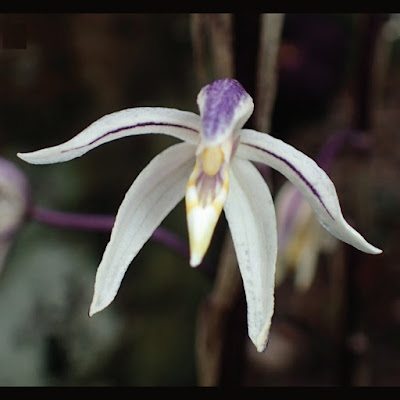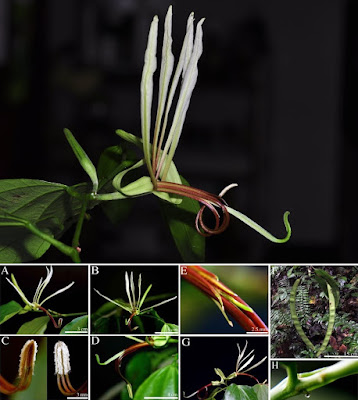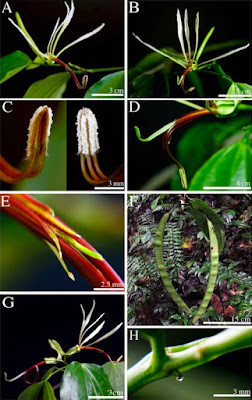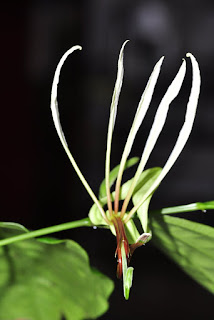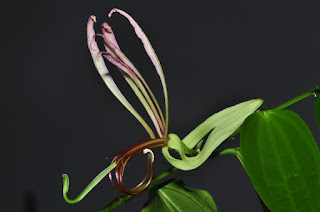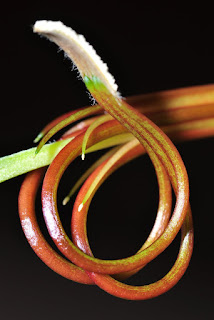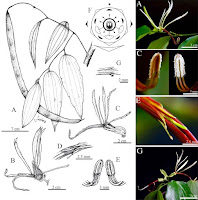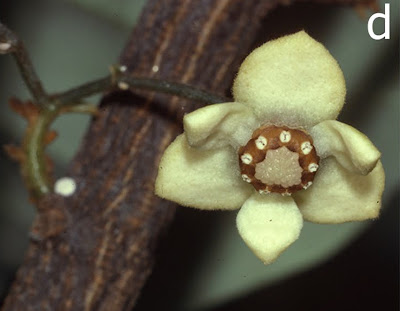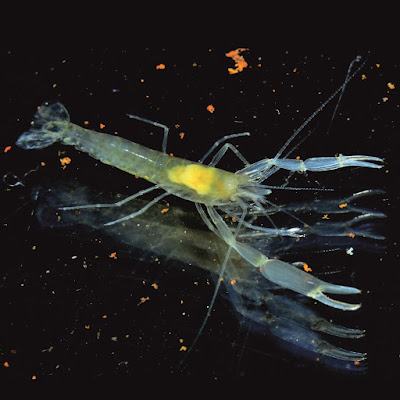[Most Recent Entries] [Calendar View]
Thursday, August 30th, 2018
| Time | Event | ||||
| 4:24a | [Botany • 2018] Aphyllorchis maliauensis (Orchidaceae) • A New Species from the Maliau Basin, Sabah, Borneo
Aphyllorchis Blume (1825: 16) comprises approximately 30 species distributed from Sri Lanka, the western Himalayas, and China through Indochina, Malaysia, Indonesia, Taiwan and the Philippines eastward to New Guinea and Australia (Hsieh et al. 2013, Tian et al. 2013). Aphyllorchis species are leafless and mycoheterotrophic, with erect, unbranched stems, racemose inflorescences, multiple resupinate flowers, petals similar to sepals but shorter and narrower and lips divided into hypochile and epichile (Tian et al. 2013). As in most other mycoheterotrophs (Suetsugu 2017, Suetsugu & Nishioka 2017, Suetsugu et al. 2017), the diversity of Aphyllorchis species could be underestimated since the short flowering season and inconspicuous habit make them easily overlooked in the wild (Hsieh et al. 2013).
Aphyllorchis maliauensis Suetsugu, M. Suleiman & Tsukaya, sp. nov. Aphyllorchis maliauensis is similar to A. montana Reichenbach (1876: 57) but differs in having larger narrowly ovate to lanceolate sepals and larger lanceolate lateral petals. Distribution, phenology, and conservation status:— Fewer than 10 individuals of Aphyllorchis maliauensis were observed at two locations in the wet understory of a kerangas forest in the Maliau Basin Conservation Area, which is dominated by Agathis species and dipterocarps. In addition, only one individual of A. maliauensis was observed in the Imbak Canyon Conservation Area, Sabah, under a lowland dipterocarp forest. Aphyllorchis maliauensis flowers in mid-August in both populations. Furthermore, it is likely that A. maliauensis is distributed more widely because it seems to have sometimes been misidentified as the more widespread species, A. montana, which has similar gross morphology. For example, the Aphyllorchis sp. recorded as A. montana by Beaman et al. (2001; Sarawak, Borneo) and Wood (2003; Sabah, Borneo) appears identical to A. maliauensis, judging from their photographs. However, the original descriptions and subsequent literature clearly indicate that there is little morphological variation in A. montana sensu Reichenbach (1876), despite its extensive distribution, which includes Sri Lanka, Assam, southern India, the Philippines, Borneo, Thailand, Taiwan, Japan and Indonesia (Reichenbach 1886, Hooker 1890, Schlechter 1906, Ames 1908, Hayata 1911, Downie 1925, Fukuyama 1934, Roy et al. 2009, Aravindhan et al. 2013, Rao & Kumar 2015, Fig. 4). Because the morphological differences between A. maliauensis and A. montana are clear and stable, A. maliauensis should be treated as an independent species rather than as an infraspecific taxon of A. montana. Conducting additional surveys for A. maliauensis during the flowering season would reveal its precise distribution. Kenji Suetsugu, Monica Suleiman, Florina Anthony and Hirokazu Tsukaya. 2018. Aphyllorchis maliauensis (Orchidaceae), A New Species from the Maliau Basin, Sabah, Borneo. Phytotaxa. 367(1); 85–90. DOI: 10.11646/phytotaxa.367.1.10 | ||||
| 10:18a | [Botany • 2018] Bauhinia proboscidea (Fabaceae: Cercidoideae) • A New Species from Costa Rica and Panama, with notes on B. beguinotii, B. gorgonae and B. pansamalana
Abstract Bauhinia proboscidea, a new species from Costa Rica and Panama, is described and illustrated, and compared to the closely related B. pansamalana of southern Mexico, Guatemala and Honduras. It is also compared with B. beguinotii, with which has been confused in herbaria. Bauhinia gorgonae, endemic to Gorgona Island in Colombia and which has been classified as a variety of B. beguinotii, is here considered a separate species. A key to the Neotropical species of Bauhinia with three fertile stamens is provided. Some observations on the morphology and reproductive biology of B. proboscidea are presented. Global-level assessments of the conservation status according to IUCN Red List criteria indicate that B. proboscidea and B. beguinotii (which was previously assessed using some misidentified records) should both be considered as species of Least Concern (LC), B. gorgonae should be considered as Endangered (EN), and B. pansamalana should be considered Not Threatened (NT). Country-level conservation assessments are also provided for all four species. The homology of the “intrastipular spines” of Bauhinia is briefly discussed. Keywords: Central America, conservation, intrastipular spines, IUCN Red List categories, taxonomy, reproductive biology, Eudicots Bauhinia proboscidea P. Juárez, R. Flores & M.A. Blanco, sp. nov. Etymology:— The specific epithet refers to the prominent staminal tube and the projecting pistil (the latter in hermaphroditic flowers), which together resemble a snout or proboscis of an animal. The recurved fertile stamens of hermaphroditic flowers also bear a superficial resemblance to the tusks of elephants Loxodonta spp., order Proboscidea). Pedro Juárez, Rodolfo Flores and Mario A. Blanco. 2018. Bauhinia proboscidea (Fabaceae: Cercidoideae), A New Species from Costa Rica and Panama, with notes on B. beguinotii, B. gorgonae and B. pansamalana. Phytotaxa. 361(1); 25-40. DOI: 10.11646/phytotaxa.361.1.2 Researchgate.net/publication/326470197_Bauhinia_proboscidea_a_new_species_from_Costa_Rica_and_Panama Resumen: Se describe e ilustra Bauhinia proboscidea, una nueva especie de Costa Rica y Panamá, y se compara con la cercanamente emparentada B. pansamalana del sur de México, Guatemala y Honduras. También se compara con B. beguinotii, con la cual se ha confundido en los herbarios. Bauhinia gorgonae, endémica de la Isla Gorgona en Colombia, se considera aquí como una especie independiente de B. beguinotii, de la cual se ha clasificado como una variedad. Se brinda una clave para las especies neotropicales de Bauhinia con tres estambres fértiles. Se presentan algunas observaciones sobre la morfología y biología reproductiva de B. proboscidea. Evaluaciones a nivel global del estado de conservación de acuerdo con los criterios de la Lista Roja de UICN, indica que tanto B. proboscidea como B. beguinotii (que había sido previamente evaluada usando algunos registros mal identificados) deben ser consideradas como especies de Preocupación Menor (LC), B. gorgonae debe considerarse como En Peligro (EN), y B. pansamalana debe considerarse como No Amenazada (NT). También se presentan evaluaciones de conservación a nivel de país para las cuatro especies. Se discute brevemente la homología de las “espinas intraestipulares” de Bauhinia. | ||||
| 10:29a | [Botany • 2018] Floral Evolution by Simplification in Monanthotaxis (Annonaceae) and Hypotheses for Pollination System Shifts Abstract Simplification by reduction has occurred many times independently in the floral evolution of angiosperms. These reductions have often been attributed to changes in reproductive biology. In the angiosperm plant family Annonaceae, most species have flowers with six petals, and many stamens and carpels. In the genus Monanthotaxis several deviations from this pattern have been observed, including flowers that contain three petals and three stamens only. New DNA sequences were generated for 42 specimens of Monanthotaxis. Five chloroplast markers and two nuclear markers for 72 out of 94 species of Monanthotaxis were used to reconstruct a phylogeny of the genus, which revealed several well-supported, morphologically distinct clades. The evolution of four quantitative and two qualitative floral characters was mapped onto this phylogeny, demonstrating a reduction in flower size and number of flower parts in Monanthotaxis. A large variation in stamen forms and numbers, strong correlations between petal size, stamen and carpel number, combined with a non-gradual mode of evolution and the sympatric co-occurrence of Monanthotaxis species from different clades suggest that the high diversity in the African rainforest of this genus is caused by switches in pollination systems. Paul H. Hoekstra, Jan J. Wieringa, Erik Smets and Lars W. Chatrou. 2018. Floral Evolution by Simplification in Monanthotaxis (Annonaceae) and Hypotheses for Pollination System Shifts. Scientific Reports. 8(12066). DOI: 10.1038/s41598-018-30607-2 1 'Small is Beautiful': floral evolution in Monanthotaxis, a tiny-flowered yet species-rich African genus of #Annonaceae. Just out in Scientific Reports, https://goo.gl/dc6y7a . @PirieMike @tlpcouvreur @timutteridge @RenskeOnstein @hsauquet_rbgsyd | ||||
| 10:30a | [Crustacea • 2018] Eurindicus bhugarbha • The Discovery of Euryrhynchidae (Decapoda) in India, with the Description of A New Genus and Species
Abstract A new genus and species of Euryrhynchidae is described from Kerala, India. This freshwater shrimp family was previously only known from northern South America and West Africa. Although the inclusion of the genus in Euryrhynchidae is unequivocal (e.g. shape of the accessory ramus of the antennular flagellum, frontal margin of the carapace, telson ornamentation), the presence of a number of unique characters makes the relative placement of the genus within the family unclear, but likely basal to the other genera. The new genus can be easily distinguished from all others within the family by these characters, e.g. the upper antennular flagellum and its accessory ramus being joined over three divisions, the presence of a reduced carpo-propodal brush and a well-developed branchiostegal groove. Keywords: Crustacea, Euryrhynchidae, systematics, subterranean, India, new genus Order Decapoda Latreille, 1802 Infraorder Caridea Dana, 1852 Family Euryrhynchidae Holthuis, 1950
Eurindicus gen. nov. Type species. Eurindicus bhugarbha sp. nov., by present designation and monotypy. Etymology. Eurindicus is an arbitrary combination of ‘Eur-’ the first three letters of the family Euryrhynchidae, and ‘-indicus’, from India, based on the geographic distribution of the genus, this being the first record of the family in India; gender masculine. Eurindicus bhugarbha sp. nov. Etymology. The species name ‘bhugarbha’ means underground in Malayalam, the native language spoken in the State of Kerala in southern India, used as a noun in apposition. Sammy De Grave, Charambilly Purushothaman Arjun a |
| << Previous Day |
2018/08/30 [Calendar] |
Next Day >> |
